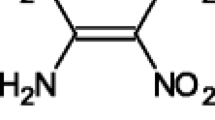Abstract
Cyclic voltammetric reduction of 17 different organic halides including alkyl, allyl, and benzyl chlorides, bromides, and iodides in aprotic media (DMF, DMSO, and acetonitrile, AN), containing 0.1 M Bu4NClO4, have been reported at glassy carbon (gc) and graphite as working electrodes. A single two-electron irreversible and diffusion-limited reduction of the carbon-halogen bond is observed, the reduction potentials ranging from −1.20 to −2.70 V (versus silver wire quasireference electrode) depending on the halide, the solvent, and the electrode. Indirect reduction of these 17 halides, however, is effected at much lower potentials (−0.79 to −0.92 V versus SCE) depending on the experimental conditions by in situ electrogenerated superoxide ion (O ⋅−2 ) by CPE. The products have been characterized by TLC, GC, CV, or chemical estimation. The diorganic peroxide and the organic hydroperoxide were the major products. In case of tertiary alkyl halides, however, alkenes predominated, due to basic nature of O ⋅−2 in these reactions. These studies indicate sufficient strength of O ⋅−2 as a nucleophile or base depending on the experimental conditions.
Similar content being viewed by others
REFERENCES
Mann, C.K. and Barnes, K.K., Electrochemical Reactions in Nonaqueous Systems, New York: Marcel Dekker, 1970, ch. 7.
Casanova, J. and Eberson, L., Electrochemistry of the Carbon-Halogen Bond, Patai, S., Ed., New York: Interscience, 1973, ch. 15.
Vasudevan, D., PhD Thesis, Indian Inst. Technol., 1989.
Ruff, L.E., Chem. Soc. Rev., 1977, vol. 6, p. 195.
Corey, E.J., Nicolaou, K.C., and Shibasaki, M., J. Chem. Soc., Chem. Commun., 1975, p. 658.
Vasudevan, D. and Wendt, H., J. Electroanal. Chem., 1995, vol. 192, p. 69.
Sawyer, D.T. and Gibian, M.J., Tetrahedorn, 1979, vol. 35, p. 1471.
Sawyer, D.T. and Valentine, J.S., Acc. Chem. Res., 1981, vol. 14, p. 393.
Simonet, J., Organic Electrochemistry: An Introduction and a Guide, Baizer, M.M. and Lund, H., Eds., New York: Marcel Dekker, 1983, p. 862.
Mair, R.D. and Hall, R.T., Organic Peroxides, Swern, D., Ed., New York: Wiley Interscience, 1971, vol. 2, p. 553.
Perex test, Merck, 1992–93, p. 1029.
Homer, L. and Jurgens, E., Angew. Chem., 1958, vol. 70, p. 266.
Davies, A.G., Organic Peroxides, London: Butterworths, 1961, p. 1.
Vasudevan, D., Bull. Electrochem., 2000, vol. 16, p. 277.
Author information
Authors and Affiliations
Additional information
From Elektrokhimiya, Vol. 41, No. 3, 2005, pp. 350–355.
Original English Text Copyright © 2005 by Vasudevan.
This article was submitted by the author in English.
Rights and permissions
About this article
Cite this article
Vasudevan, D. Direct and indirect electrochemical reduction of organic halides in aprotic media. Russ J Electrochem 41, 310–314 (2005). https://doi.org/10.1007/s11175-005-0067-2
Received:
Issue Date:
DOI: https://doi.org/10.1007/s11175-005-0067-2




